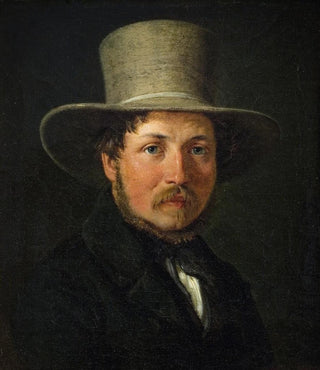Art print | The painter Christen Købke - Wilhelm Marstrand


View from behind

Frame (optional)
Art print of The painter Christen Købke - Wilhelm Marstrand – Captivating introduction
In the fascinating world of 19th-century Danish art, the artwork "The painter Christen Købke - Wilhelm Marstrand" stands out for its brilliance and depth. This piece, which captures the very essence of genre and portrait painting, transports us to a suspended moment where the artist’s gaze meets that of the viewer. The depiction of Købke, with his contemplative look and relaxed posture, evokes both the passion and the rigor that animate every creator. This painting is not just a simple portrait; it is an invitation to explore the nuances of the human soul through the lens of art.
Style and uniqueness of the work
The style of this artwork is emblematic of Romantic realism, a movement that seeks to capture the truth of everyday life while preserving a certain poetry. The color palette chosen by Marstrand is subtle, oscillating between soft tones and luminous highlights that animate Købke’s face. Every brushstroke seems to be a caress, revealing the texture of the skin and the depth of emotions. The composition, carefully balanced, highlights the subject while incorporating elements of the environment that speak of the era and context in which the artist evolves. The details, whether it is light filtering through a window or everyday objects arranged around him, are silent witnesses to Købke’s inner life, making this work a true masterpiece.
The artist and his influence
Wilhelm Marstrand, a key figure in Danish art, managed to leave his mark on his era through his ability to fuse realism with romantic sensitivity. As a student of the renowned Royal Danish Academy of Fine Arts in Copenhagen, he was influenced by masters such as Christoffer Wilhelm Eckersberg, whose impact is felt in the precision of his portraits and the delicacy of his compositions. Marstrand also had the opportunity to travel to Italy, where he drew invaluable inspiration from the works of the great Renaissance masters. This allowed him to enrich his own artistic language, blending tradition and innovation. His work "The painter

Matte finish

View from behind

Frame (optional)
Art print of The painter Christen Købke - Wilhelm Marstrand – Captivating introduction
In the fascinating world of 19th-century Danish art, the artwork "The painter Christen Købke - Wilhelm Marstrand" stands out for its brilliance and depth. This piece, which captures the very essence of genre and portrait painting, transports us to a suspended moment where the artist’s gaze meets that of the viewer. The depiction of Købke, with his contemplative look and relaxed posture, evokes both the passion and the rigor that animate every creator. This painting is not just a simple portrait; it is an invitation to explore the nuances of the human soul through the lens of art.
Style and uniqueness of the work
The style of this artwork is emblematic of Romantic realism, a movement that seeks to capture the truth of everyday life while preserving a certain poetry. The color palette chosen by Marstrand is subtle, oscillating between soft tones and luminous highlights that animate Købke’s face. Every brushstroke seems to be a caress, revealing the texture of the skin and the depth of emotions. The composition, carefully balanced, highlights the subject while incorporating elements of the environment that speak of the era and context in which the artist evolves. The details, whether it is light filtering through a window or everyday objects arranged around him, are silent witnesses to Købke’s inner life, making this work a true masterpiece.
The artist and his influence
Wilhelm Marstrand, a key figure in Danish art, managed to leave his mark on his era through his ability to fuse realism with romantic sensitivity. As a student of the renowned Royal Danish Academy of Fine Arts in Copenhagen, he was influenced by masters such as Christoffer Wilhelm Eckersberg, whose impact is felt in the precision of his portraits and the delicacy of his compositions. Marstrand also had the opportunity to travel to Italy, where he drew invaluable inspiration from the works of the great Renaissance masters. This allowed him to enrich his own artistic language, blending tradition and innovation. His work "The painter






